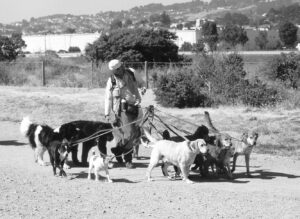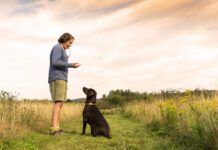The domestic dog is, inarguably, a social species. There is little scholarly disagreement over the fact that the dog’s social dependency makes him exceptionally aware of the behavior of others, and contributes to his own behavior and learning abilities.
There is, however, ongoing discussion about how much, and how, dogs can learn by interacting with each other – the question of “social learning” through contact, joining in the action, and pure observation without active participation.
You may have seen it yourself when you got a new puppy. You’re positive ol’ Spot taught little Junior where to go to the bathroom in the yard, how to find the water dish, and the importance of barking vociferously at strangers. Junior certainly came running hot on Spot’s heels when you called the pair, thus learning the importance of the word “come.” It even seems like the new pup learned how to sit politely for a treat by watching Spot perform that well-practiced behavior. But did he really learn by watching Spot? Or was it all just coincidence?

Social Learning
The term “social learning” encompasses several closely-related concepts. Some clearly apply to the learning processes of dogs. Others are more debatable.
Allelomimetic behavior (mimicking), or group-coordinated behavior, relies on the hardwired inclination of a social animal to follow and mimic members of the social group. Puppies are genetically programmed to follow and copy others of their kind. This is an important factor in early learning; it comes into play when Junior chases along when you call Spot, or when you run away from Junior and call him to chase after you.
Social facilitation is related to but different from allelomimesis. It refers to behaviors performed in a group, where the presence of another dog causes an increase in the intensity of the behavior. Two dogs acting in concert may run faster, bark louder, jump higher, eat more, or eat faster than a dog performing alone. For this reason, trainers and behaviorists often caution against adopting a second dog for the primary purpose of resolving the behavior problems of Dog #1; you can easily end up with louder barking, or an increase in destructive behaviors, rather than the hoped-for decrease in undesirable behavior.
It is likely that the amplified magnitude of behavior is a result of an increased state of arousal, stimulated by the presence of one or more additional dogs. While the negatives of this effect are obvious, social facilitation can have a positive effect as well, such as the increased speed and intensity of a competitive flyball dog due to the presence of the running dog in the next lane.
The flip side of social facilitation is called social interference – the irritating phenomenon that occurs when the presence of other dogs playing nearby interrupts your dog’s ability to pay attention to your training session. This is known in training class as a “distraction.” It’s wise to teach Junior his new behaviors in a quiet environment, free from such social interference. Make sure he knows them well before you can expect him to be able to perform them in the face of major distractions.
Local enhancement includes pieces of social facilitation, mimicking, and trial-and-error learning, but is different from true observational learning in that the dog actively participates in the behavior in the presence of the other dog and/or other environmental cues. Spot starts digging a hole; Junior joins in, and learns that digging holes is fun and rewarding as he follows Spot under the fence. Simply watching Spot dig the hole was not enough to inspire Junior to dig his way out of the yard; it was actually a combination of watching, participating, and enjoying the whole process that characterizes this as local enhancement.
Another example of local enhancement is when Junior learns to coordinate his clumsy puppy legs and jump into the car much more quickly by following behind Spot than he would by trying to climb in on his own. Junior’s performance is enhanced by Spot’s immediate example, and learning happens more quickly for Junior as a result.

The Extent of Dogs’ Observational Learning
This brings us to the controversial question of true observational learning in dogs. Can our canine pals learn by simply watching?
“No” is an easy answer. Four necessary conditions for observational learning are: attention, retention, motivation, and production. That is, the dog must pay attention to the dog performing the modeled behavior; retain the information gathered about the behavior during the observation; be motivated to reproduce the behavior in a time and place removed from the original; and finally, produce the behavior, or some reasonable facsimile thereof.
In training, for example, one dog could watch you through a window while you train another dog to lie down on cue. You could then take the observer dog to a new room and have him perform the down behavior for you, on cue. Not likely!
If dogs were adept at observational learning, you could plop Junior in front of the television, pop in your favorite videotape about clicker training, leave him there while you head off to work, and come home to a trained dog. There would be no need for dog trainers, or dog training classes. Sometimes we wish it were that easy!
Still, some studies have determined that puppies, at least, have some capacity for observational learning. A 1997 study conducted by Slabbert and Rasa determined that pups between the ages of 9-12 weeks who were permitted to observe their narcotics-detecting mothers at work generally proved more capable at learning the same skills at six months of age than control puppies the same age who were not previously allowed to watch their mothers working.
An 1977 experiment by Adler and Adler found that puppies who watched other puppies learn to pull a food cart into their cages by an attached ribbon proved considerably faster at the task when later given the opportunity themselves. At 38 days of age, the “demonstrator” puppies took an average of 697 seconds to succeed, while the observers succeeded in an average of 9 seconds.
These are startling and exciting findings. While evidence of observational learning has yet to be found in adult dogs, the potential for it in puppies may change, yet again, our definition of a responsible breeder. One day, we may come to expect good breeders to set her puppies on the sidelines so they can watch their mothers run through obedience routines, agility courses, and service dog, search-and-rescue, or drug-sniffing jobs before they are placed in their new homes.
Put a Good Dog to Work
While we wait for more scientific information on observational learning in puppies, we can take advantage of social learning opportunities that we know can enhance our dogs’ behaviors.
If your new dog is an only dog, you can still make use of his innate social mimicking behavior to encourage him to follow you while teaching him “come.”
If you do get a new dog, structure some training sessions so that he can learn from your more-experienced dog’s knowledge of good manners and skills. For example, before you open the door to let your dogs out, wait for Spot to sit (we hope he has already learned this “good manners” behavior), and then calmly wait for Junior to do the same. Spot’s calm behavior sets a good example for Junior to mimic. If Junior hasn’t quite figured out the sit, that can come later; as soon as Junior is standing calmly, open the door and let them both out as their reward for calm.
Rather than chastising Junior for barking at a passing skateboarder when you’re out playing in your fenced yard, grab Spot’s ball and run with him away from the skateboarder, playing with him in loud excitement, to make use of social facilitation to turn Junior’s unacceptable intense barking into acceptable intense play.
Finally, remember that you can utilize the presence of other dogs to amplify the magnitude of your dog’s desired behaviors, while taking care to avoid those circumstances that might amplify the undesirable ones. In other words, it might be wiser to spend more time with your new dog in the presence of well-mannered dogs at a daycare or training center than in a pack of unruly, barking dogs at a dog park.
Training a dog is a big challenge – we can use all the social learning help we can get!





